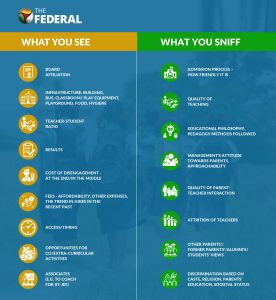
It’s admission season; how to select the right school for your child
Before filling up forms and preparing their children for entrance interviews, parents have to shortlist schools supported by boards that are compatible with their children’s planned careers

The annual school admission season is here. Parents seeking admission for children in schools face a harsh reality. Filling up forms, devising Plans A to Z if the most sought-after schools don’t work out, intensely preparing themselves as well as children for interviews, exchanging views and information with fellow anxious parents in social media groups…there is a long ‘to-do’ list to check out.
In what appears to be an atmosphere filled with anxiety and confusion, is there some logic with which one could go in selecting a school for one’s child?
Also read: Andhra, Kerala top education ministry’s Performance Grading Index
There is one criterion where you don’t have choices: your spending capacity. How much are you willing to fork out for your child’s education? It is not just about the present. Will you be able to sustain the spending till your kid completes school? Mind you, schooling costs rise steeply – it may be safe to look at a 100 per cent hike in fees over five to six years. Once you arrive at a sum, it will define the universe of schools where you can seek admission.
Keep the following checklist in mind. It should help you make the right choice.

Picking the right board
The first choice you need to make is about the school’s board affiliation. There are broadly five kinds here: Central Board of Secondary Education (CBSE), Council for the Indian School Certificate Examinations (CISCE), National Institute of Open Schooling (NIOS), various state boards, Cambridge Assessment International Education of the UK (which conducts IGCSE, A levels exams), and International Baccalaureate (which offers IB Diploma). The last two are international boards.
So how does one navigate through choices here?
Take the most popular among the boards – CBSE. Besides a perceived high-quality syllabus, CBSE holds one distinct advantage. Entrance tests to higher education such as the Joint Entrance Exam (JEE – for engineering and sciences), National Eligibility cum Entrance Test (NEET – for medical education) as well as the recently introduced Common Universities Entrance Test (CUET – for central as well as other universities) are based on material produced by NCERT and used by the CBSE board. That pretty much covers all the options in higher education in India.
According to a report in Education Times, more than 50,000 applicants who found their names on the first list for admission to Delhi University were from schools affiliated to the CBSE board. In contrast, about 342 students from Kerala’s state board, 1,348 from Bihar’s state board, and 1,057 from Uttar Pradesh’s board made it to the list. The scenario in JEE and NEET would not be different.
Also read: Vedic Mathematics is neither truly vedic nor accurate, rigorous maths
CISCE (popularly known as ‘ICSE’) conducts ISC (Indian School Certificate) exams for Class XII students. Perceived to be ‘superior’ to the CBSE board exam, it helps students glide into undergrad education more easily than others, but increasingly doesn’t help in cracking entrance tests.
Special cases
NIOS is meant for students who cannot go to school regularly, who move from one location to another, thanks to the nature of their parents’ work, or who have special needs of some kind.
However, increasingly it is being used by students who want to drop out of school, and focus on preparing for tough entrance tests such as the JEE. Arjun Bharat, who topped the IIT-JEE in Tamil Nadu in 2017, went through the NIOS stream. Students who exhibit extraordinary talent in fine arts or sports also consider NIOS favourably.
State boards have been steadily losing to CBSE and CISCE in terms of preference. Very few new private schools prefer state boards. Most schools affiliated with a state board are run or supported by the government of the concerned state. However, they too offer some benefits.
Sops for state board students
Some governments, such as that in Tamil Nadu, offer a quota for state board students in admission to medical colleges. Tamil Nadu allocates 7.5 per cent of seats in medical education to students from government schools which are invariably attached to the state board. Also, if one is placed within the top 1 percentile in the Class XII board exam of any board, there is a separate, easier route for entry into prestigious research institutions such as the seven Indian Institutes of Science Education and Research (IISER).
Also read: How Delhi govt transformed its schools, and the challenges it faces
In many states, it is enough to score much lower marks to be within the top 1 percentile compared to national boards such as CBSE and CISCE. For instance, in 2022, while CBSE’s 1 percentile was above 430 out of 500, the equivalent for Assam was only 365.
A board for foreign education aspirants
As for overseas boards, IB diploma, and, to a lesser extent, Cambridge-promoted A levels, offer scope to secure admission abroad for undergraduate education. So, if you aim to send your child abroad after Class XII, this should be the preferred route. That said, the cost of schooling is relatively high. IB is perhaps the most expensive school education in India. And many schools that claim to train students for these exams don’t do it well since the teachers are not adequately trained.
Beyond the boards, you should consider choices such as alternative school vs mainstream school, co-ed school vs single-gender school, residential school vs day-boarding school, and neighbourhood school vs school at a distance before jotting down a list.
(The author consults in the education domain. He can be reached at srihamsa@gmail.com)


